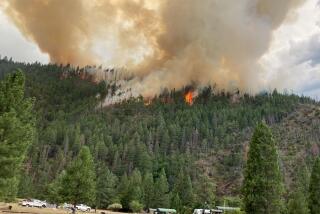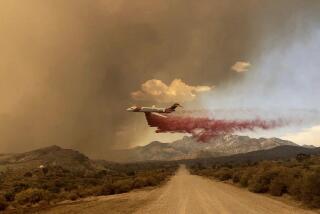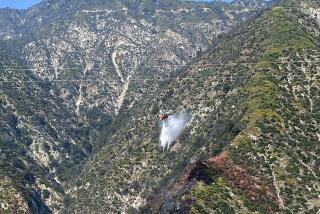Wildfire in Plumas National Forest is California’s largest so far this year
A massive wind-driven wildfire in Northern California’s Plumas National Forest grew to nearly 44,000 acres Monday and is the state’s largest blaze so far this year.
The Walker fire, which broke out Wednesday, has consumed more than 68 square miles and is burning in remote mountainous terrain about 150 miles northeast of Sacramento. It is about 7% contained.
No structures have been destroyed and no injuries reported.
Evacuation orders were lifted for homes along a stretch of Highway 395, including the communities of Milford and Brockman Canyon, about 11 a.m. Monday, but residents were told to remain prepared to leave again. Mandatory evacuation orders remained in place for several other rural towns, including Antelope Lake, the Genesee Valley road corridor, the Ward Creek area and the Flournoy Bridge area. Authorities opened an evacuation center at the Lassen County Fairgrounds.
The fire initially burned through thick undergrowth in the Genesee Valley before hitting some pockets of previously burned terrain in the Antelope Lake area. It has skirted the burn scars and is now charring thickets of sagebrush, juniper and Jeffrey pines, said Brigitte Foster, a fire prevention officer for the U.S. Forest Service.
About 825 firefighters are battling the wildfire, but their efforts have been hampered by erratic afternoon winds, Foster said. The weather conditions were expected to persist Monday, though slightly cooler temperatures, higher humidity and a chance of showers later in the day into Tuesday could help firefighters.
The National Weather Service tweeted images of the fire’s smoke plume pushing into Nevada.
The wildfire is one of several that have erupted in the last week in what has been a slow start to the state’s fire season.
About 100 miles west, the Red Bank fire, which is burning in a remote area of Tehama County mostly used for cattle ranching, has reached 8,838 acres and destroyed two structures.
The fire started Thursday and is believed to have been caused by lightning. Authorities had lifted all evacuation orders and reported 50% containment of the blaze as of Monday afternoon.
Lightning is also suspected of having sparked a second blaze a couple miles west of the Red Bank fire. The South fire, which also began Thursday, has grown to about 2,425 acres.
Farther south, in the Inyo National Forest, the Taboose fire is at 10,500 acres and 10% contained. Though firefighters were able to slow the spread of the fire Sunday night into Monday morning, there was concern that weather conditions could fuel further growth Monday afternoon.
The National Weather Service issued a red flag warning for Mono County and the eastern portion of Alpine County because of gusty winds and low humidity. The warning is meant to alert the public to weather that could result in extreme fire behavior.
In Riverside County, the Tenaja fire is now 90% contained after burning about 1,926 acres in the Murrieta area. The fast-moving fire had prompted evacuation orders affecting hundreds of residents, but many were permitted to return home on Friday.
Firefighters in Los Angeles County prepared for the start of fire season with the arrival of two Canadian firefighting aircraft known as “super scoopers.”
The fixed-wing Canadair Bombardier CL-415s, which are on loan from the provincial government of Quebec, arrived at an L.A. County Fire Department tanker base near the Van Nuys Airport on Aug. 30 and officially went into service Sept. 1, said Capt. Tony Imbrenda, a spokesman for the department.
The aircraft can carry 1,600 gallons of water and are able to quickly drop it on a fire, then rapidly refill and return to the scene. The county has been leasing them during each fire season for the last 26 years at a cost of $3 million to $3.5 million, Imbrenda said.
The arrival of the planes comes at a time of year when offshore weather patterns typically bring hotter, drier and windier conditions to the area, drying out fuels and increasing the probability of ignition, Imbrenda said.
This year has been relatively tame compared with last year, which saw more than 1.8 million acres burn across the state. But authorities said they’re ready for that to change in an instant.
“The weather is such that it could support that type of fire season,” Imbrenda said. “So whether or not it’s going to happen, it remains to be seen, but we always prepare for the worst.”
More to Read
Start your day right
Sign up for Essential California for news, features and recommendations from the L.A. Times and beyond in your inbox six days a week.
You may occasionally receive promotional content from the Los Angeles Times.







